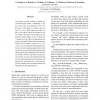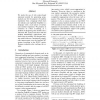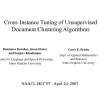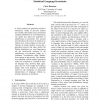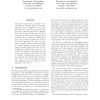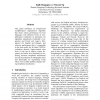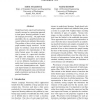NAACL
2007
14 years 1 months ago
2007
The immense prosodic variation of natural conversational speech makes it challenging to predict which words are prosodically prominent in this genre. In this paper, we examine a n...
NAACL
2007
14 years 1 months ago
2007
We study the use of rich syntax-based statistical models for generating grammatical case for the purpose of machine translation from a language which does not indicate case explic...
NAACL
2007
14 years 1 months ago
2007
We propose a novel HMM-based framework to accurately transliterate unseen named entities. The framework leverages features in letteralignment and letter n-gram pairs learned from ...
NAACL
2007
14 years 1 months ago
2007
NAACL
2007
14 years 1 months ago
2007
A novel random text generation model is introduced. Unlike in previous random text models, that mainly aim at producing a Zipfian distribution of word frequencies, our model also ...
NAACL
2007
14 years 1 months ago
2007
This paper explores the potential for annotating and enriching data for low-density languages via the alignment and projection of syntactic structure from parsed data for resource...
NAACL
2007
14 years 1 months ago
2007
This paper introduces an unsupervised morphological segmentation algorithm that shows robust performance for four languages with different levels of morphological complexity. In p...
NAACL
2007
14 years 1 months ago
2007
The quality of a sentence translated by a machine translation (MT) system is difficult to evaluate. We propose a method for automatically evaluating the quality of each translati...
NAACL
2007
14 years 1 months ago
2007
We present a novel machine translation framework based on kernel regression techniques. In our model, the translation task is viewed as a string-to-string mapping, for which a reg...
NAACL
2007
14 years 1 months ago
2007
Graph-based semi-supervised learning has recently emerged as a promising approach to data-sparse learning problems in natural language processing. All graph-based algorithms rely ...
